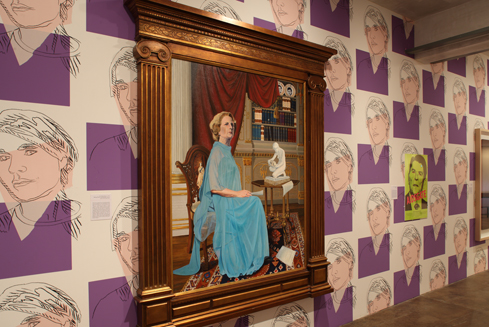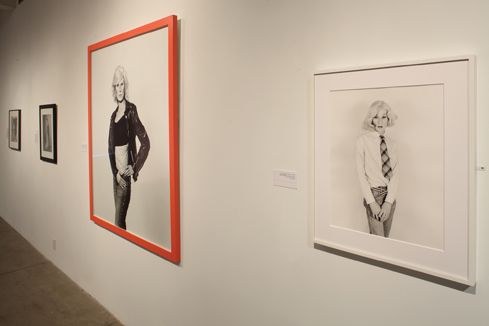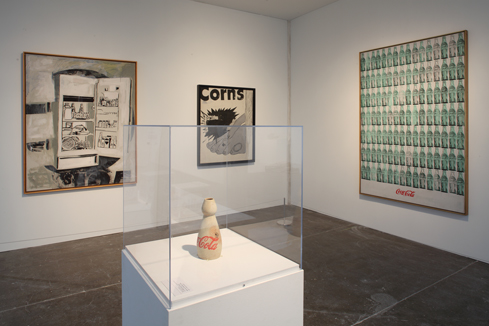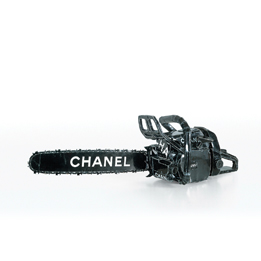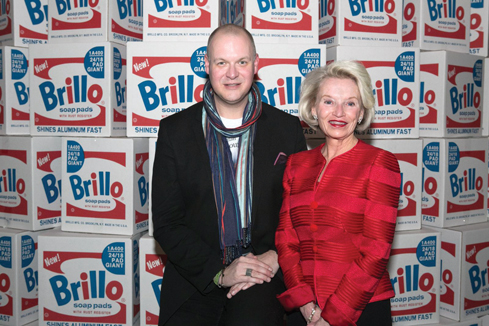 |
||||||||||||||||||||
|
At The Warhol showing of Regarding Warhol: work by Andy Warhol and Cory Arcangel intermingle in the museum's famous Silver Clouds gallery. Photo: Richard Stoner |
Under the Influence
How much did Andy Warhol impact the art world? A new exhibition at The Warhol tries to count the ways—through the works of 60 other artists.Critics have long acknowledged that Andy Warhol changed the very nature of contemporary art. Last year, the Metropolitan Museum of Art—hardly known for its forays into the contemporary—took the bold step of attempting to show how. The Met’s exhibition, Regarding Warhol: Sixty Artists, Fifty Years, on view at The Andy Warhol Museum through April 28 and sponsored by PNC Financial Services, explores the full range of Warhol’s enduring, five-decade-long legacy by pairing his work with those of 60 contemporary artists. Brillo boxes, Jackies, experimental films, and other Warholian icons are paired with the work of such greats as John Baldessari, Jeff Koons, Barbara Kruger, Catherine Opie, Robert Gober, Cindy Sherman, Ai Weiwei, and dozens of others. Cory Arcangel, one of the Sixty Artists, had yet to see Andy Warhol’s Silver Clouds when in 2002 he created his own Pop art cloudscape by altering an ‘80s-vintage Nintendo cartridge. But the then-24-year-old was absolutely thinking of Warhol when he stripped Mario, Luigi, and other graphics from the classic video game, leaving only clouds scrolling across a blue sky: “It’s a broken, nonfunctional Super Mario Brothers,” explains the artist. As soon as he finished Super Mario Clouds, Arcangel dug even deeper into the Warholian psyche of technology and pop culture by modifying an old Hogan’s Alley cartridge to create a game titled I Shot Andy Warhol. Players rack up points for zapping Warhol’s mug while avoiding hits on the Pope, Flavor Fav, and Colonel Sanders. “Warhol was always in the back of my mind,” Arcangel says of the project. So when the Met approached him last fall about displaying his white clouds alongside Warhol’s famous Mylar ones in Regarding Warhol, Arcangel was thrilled. “It was mind-blowing,” he recalls. Today, Arcangel’s clouds intermingle with Warhol’s famous helium-filled ones as part of The Warhol’s incarnation of Regarding Warhol. Warhol’s silver clouds waft past projections of the Super Mario Clouds, periodically blocking out the images as they cast shadows. “It’s very exciting, really an honor,” Arcangel says.
The Pittsburgh show, no surprise, includes many more prized Warhol works than the Met’s debut. And the museum’s rich archive has enabled the curators to draw new links between Warhol and contemporary artists by adding twists like the intermingled clouds. Spread out across six floors of Andy’s museum, some 100 modern masterpieces— the overwhelming majority of which have never before been seen in Pittsburgh—are displayed alongside dozens of works by Warhol, who died at age 58 in 1987. “It’s thrilling to look at contemporary art production over the last 50 years through the lens of Warhol,” says Eric Shiner, director of The Warhol. “Warhol has been front and center since day one with the release of the Campbell’s Soup cans in 1962.” The Warhol effectWarhol found art in everything from paint to film, from mundane consumer goods to celebrity glamour. His versatility, combined with brilliant self-marketing, draws in diverse audiences that experience his work from myriad points of view.
“The interesting thing about Andy is that his influence can be found well beyond the art world,” says Nicholas Chambers, the Milton Fine Curator of Art at The Warhol. “People come to Warhol through fashion, music, publishing, through photography. I like to think Warhol set up a feedback loop between what he was doing as an artist and popular culture more broadly. He depicted the world of consumer culture, while also working from the inside, inserting himself into the very machinery of pop culture.” The Warhol effect is screamingly obvious in the work of artist Deborah Kass. During her eight-year-long The Warhol Project, Kass channeled Warhol’s essence to recast some of his best-known works with icons from her Jewish heritage. She had already started her silkscreens, The Jewish Jackie Series, substituting Barbra Streisand for the former First Lady, when she decided to add a new twist. Sitting in her New York studio one day in 1992, she thought of Warhol’s Elvis series. Then it hit her. “Oh my God, my Elvis is Barbra’s Yentl,” she recalls. In Double Ghost Yentl (My Elvis), which appears in Regarding Warhol, she substitutes pistol-packing Elvises with twin images of Streisand in drag—a reference to the film Yentl, in which the actress portrayed a turnof- the-century shtetl girl masquerading as a boy in order to study Talmudic law. “This image was for me the perfect metaphor for being a woman making paintings,” Kass says. “It was exactly what I was doing in art, being in drag as Andy Warhol. Yentl disguised herself as a boy in order to study sacred texts. This hit all the notes: For Yentl, the love of study, or in my case, art. Barbra made this commercial movie in 1983. Queer studies didn’t exist. There was no women’s studies. She made a Hollywood movie about gender issues before anyone did it in academia.” Kass’ enduring fascination with Warhol began when she was a teenager growing up in a Jewish neighborhood on Long Island reading The New York Times. One day, in the Arts and Leisure section, she saw a photo of his 1961 canvas Before and After, which incorporated an ad for a nose job. “It was very wild to see a ritual of my tribe on display,” Kass explains. “Every older sister I knew had a nose job. This painting really hit home.” Other artists came to appreciate Warhol later in their lives. Luc Tuymans, a Belgian artist who follows a more formal, painterly approach, said he only fully appreciated Warhol when he saw the artist’s Paris retrospective in 1989. “You could easily go into denial and say that [Warhol’s work] is commercial artwork, or that there’s no profoundness to it,” he told curators in the exhibition catalogue. “However, it is the total opposite of that. It is extremely analytical.”
Like Warhol, Tuymans plucked his subjects from front-page headlines. His 2005 The Secretary of State paints a memorably unflattering portrait of Condoleezza Rice, her face flattened like a television screen, her skin rendered in an unsettling shade of grey. The gap between her teeth is visible through her pursed lips. “Condoleezza Rice would have been a perfect Warholian power figure,” Shiner says. “He was constantly depicting people from the front page of the headlines.” In fact, the painting hangs near Warhol’s portraits of Chairman Mao and Queen Elizabeth II in a section of the show titled “Portraiture: Celebrity and Power.” Installing this part of the exhibition involved more than a few logistical challenges, Shiner notes. As curators debated where to put Maurizio Cattelan’s 2003 wax sculpture of supermodel Stephanie Seymour, for example, they made arrangements to fly in her hair dresser from New York to spruce up the figure’s lux locks. Each section of the show highlights popular Warholian frameworks: the banality of daily news, his ever-famous appropriation and seriality, the art of combining business and spectacle, and of course queer studies. Perhaps one of the most striking images in the queer studies section is of Warhol himself. In the 1970s, star photographer Christopher Makos and Pop icon Warhol became close friends and collaborators. Warhol paid Makos the ultimate compliment by calling him “the most modern photographer in America.” While working for Interview, Warhol’s celebrity magazine, Makos captured such luminaries as John Lennon, Liza Minnelli, Mick Jagger, and others from Warhol’s star-studded world. Makos, who taught Warhol how to use a camera, would go on to take some of the most mesmerizing images of his famous friend, with whom he would fly overseas on the Concorde. In 1981, the two decided to collaborate on a project that explored transgender themes, with Warhol as the subject. But they decided not to go the traditional drag queen route. “Halston asked us if we wanted to borrow a dress,” recalls Makos. “We said ‘no.’ Our idea was that if you changed a man’s face, it became something else.” With the aid of heavy makeup and wigs, Warhol’s face morphed into a woman’s. But from the neck down, he wore jeans with a shirt and tie. During the two-day shoot, Makos took 365 photographs of his friend in various gender-bending guises. “Andy was very relaxed in front of the camera and in front of me,” Makos explains. “I didn’t know how important these photos were at the time. When you are in the middle of making history, you don’t realize you are part of it.” “This image was for me the perfect metaphor for being a woman making paintings. It was exactly what I was doing in art, being in drag as Andy Warhol. ” – Artist Deborah KassLady Warhol, on view in the exhibition, shows Warhol exuding a Marlene Dietrichlike glamour as he fixes his gaze on the camera and crosses his hands demurely over the crotch of his men’s jeans. “Look at the fingers,” says Makos.
Chambers says Makos’ photographs of Warhol are like no one else’s: “Lady Warhol is such an arresting image. I think it says a lot about how comfortable Warhol was working with Christopher. His images capture Warhol in an utterly unique and revealing way.” Try anything—and everythingIn Western cultures, Warhol’s name was practically part of the oxygen as his Pop star fame grew. But even in closed societies, where his work was banned, he seeped into the collective consciousness.
“It’s thrilling to look at contemporary art production over the last 50 years through the lens of Warhol. Warhol has been front and center since day one with the release of the Campbell’s Soup cans in 1962.”
- Eric Shiner, Director of the Warhol
“In America, where he was the preeminent artist of the second half of the 21st century, Warhol is seen in relation to American culture,” Chambers says. “In other cultures, however, he represents a point of resistance. It’s fascinating to see different ways in which Warhol’s influence manifests itself around the world, even in places where there is very little access to his work.” Ai Weiwei, the now-famous Chinese artist and dissident, has had a long fascination with Warhol, even translating one of his texts into his native Mandarin. Weiwei was so enthralled with Warhol that he moved to New York City in 1982 just to be in the sphere of the famous artist. He immortalized his arrival by photographing himself in front of a Warhol self-portrait at the Museum of Modern Art, mimicking Warhol’s iconic pose. According to Shiner, Weiwei saw Warhol only once, from afar. Even so, Weiwei wanted to seep into the New York Pop art scene.
Warhol’s influence on Weiwei is evident in the activist’s 2010 Neolithic Vase with Coca Cola. The Warhol adds another layer of meaning to the work by substituting the real vase with a limited-edition reproduction. “What do culture and heritage really mean?” Shiner asks. “Are we more interested in centuries-old objects or are we more interested in contemporary American culture?” The international flavor of Regarding Warhol showcases the artist’s global reach. The fact that the curators decided to limit his impact to just 60 contemporary artists kicked off lively debates on who should be included. “It is impossible to do. There is no definitive list regarding Warhol,” Chambers insists. “But it gets people thinking openly and broadly about his influence.” Beyond the artwork itself, Warhol imparted a freeing attitude. “The thing I learned was, ’Just get it out. Don’t hide it,’” says Makos. “Other photographers were so precious about their work. Andy was like a conglomerate. His work ethic was over-the-top. He imparted that at The Factory.” Arcangel said Warhol’s attitude toward art was empowering: “He made films. He produced rock bands. He made paintings and installations and Interview magazine. He knew what would happen 25 years later with the Kardashians and reality TV. When I think of Warhol, I think, ‘Man, I really need to step up my game.’” In fact, Arcangel occasionally reads Warhol’s gossipy diaries for inspiration: “I read it in random places. It feels like he’s talking to you.’’ Fueling the Arts
For the past decade, PNC’s support of Carnegie Museums has been shaped by its commitment to partner with the four museums on what they do best: deliver one-of-a-kind exhibitions and educational experiences. “PNC has a 160-year tradition of enriching the communities it serves, and supporting the arts is a large part of this philosophy,” says Donna C. Peterman, executive vice president and chief communications officer of The PNC Financial Services Group. “Our partnership with Carnegie Museums has helped to provide culturally engaging programs to communities in and outside of Pittsburgh.” Since 2002, the organization’s support to Carnegie Museums has surpassed $4 million. The PNC Foundation committed more than half a million dollars to Grow Up Great with Science at the Science Center and $1 million to the creation of the Center for Lifelong Science Learning at the Museum of Natural History. More than half of PNC’s total support, however, has gone towards bringing standout exhibitions to Pittsburgh: among them, the opening of the Museum of Natural History’s Dinosaurs in The Time; the Museum of Art’s Louis Comfort Tiffany: Artist for the Ages and Teenie Harris, Photographer: An American Story, now traveling to other venues; the Science Center’s roboworld™; and The Andy Warhol Museum’s Piet (Mondrian) in Pittsburgh, Marilyn Monroe: Life as a Legend, Deborah Kass: Before and Happily Ever After, and the current exhibition, Regarding Warhol: Sixty Artists, Fifty Years. As further evidence of PNC’s appreciation for The Warhol as a cultural asset to the Pittsburgh region and beyond, the company has teamed up with the museum to export Warhol exhibitions to five cities across the country. “Our long-standing partnership with The Warhol reflects our belief in the power of the arts to strengthen communities,” says Peterman, a member of The Warhol board. “As Andy is one of the most iconic and influential artists of the 20th century, we are pleased to help bring Regarding Warhol, which explores the full extent of Warhol’s influence, to Pittsburgh.”
|
|||||||||||||||||||
The Shape of Things · Creatures of the Wild · The Carving Out of a Collection · Director's Note · NewsWorthy · Face Time: Nina Marie Barbuto · Artistic License: Permantly Interesting · Science & Nature: Survivor's Tale · About Town · The Big Picture
 |
Copyright © 2017 CARNEGIE Magazine. All rights reserved. |



